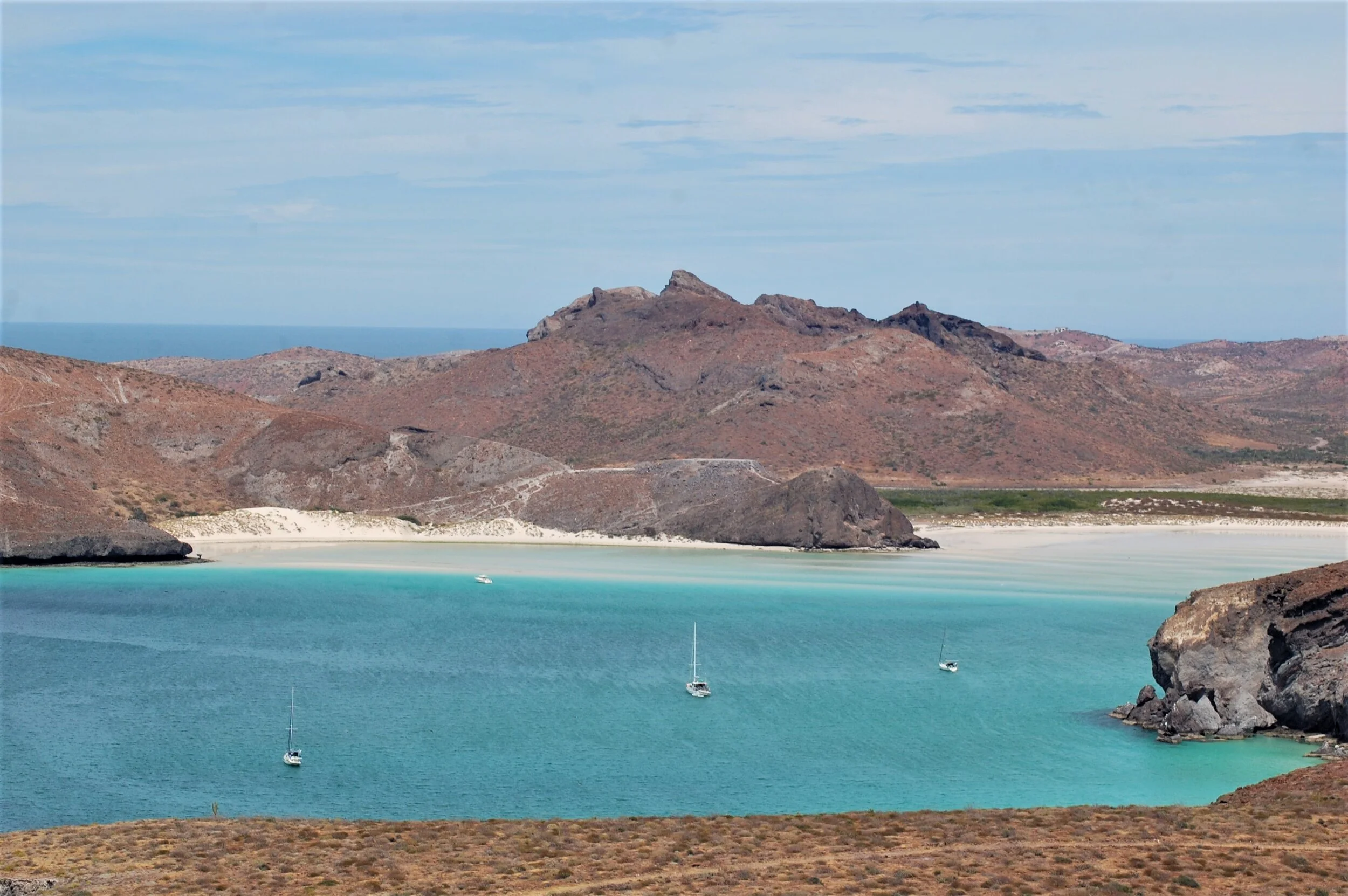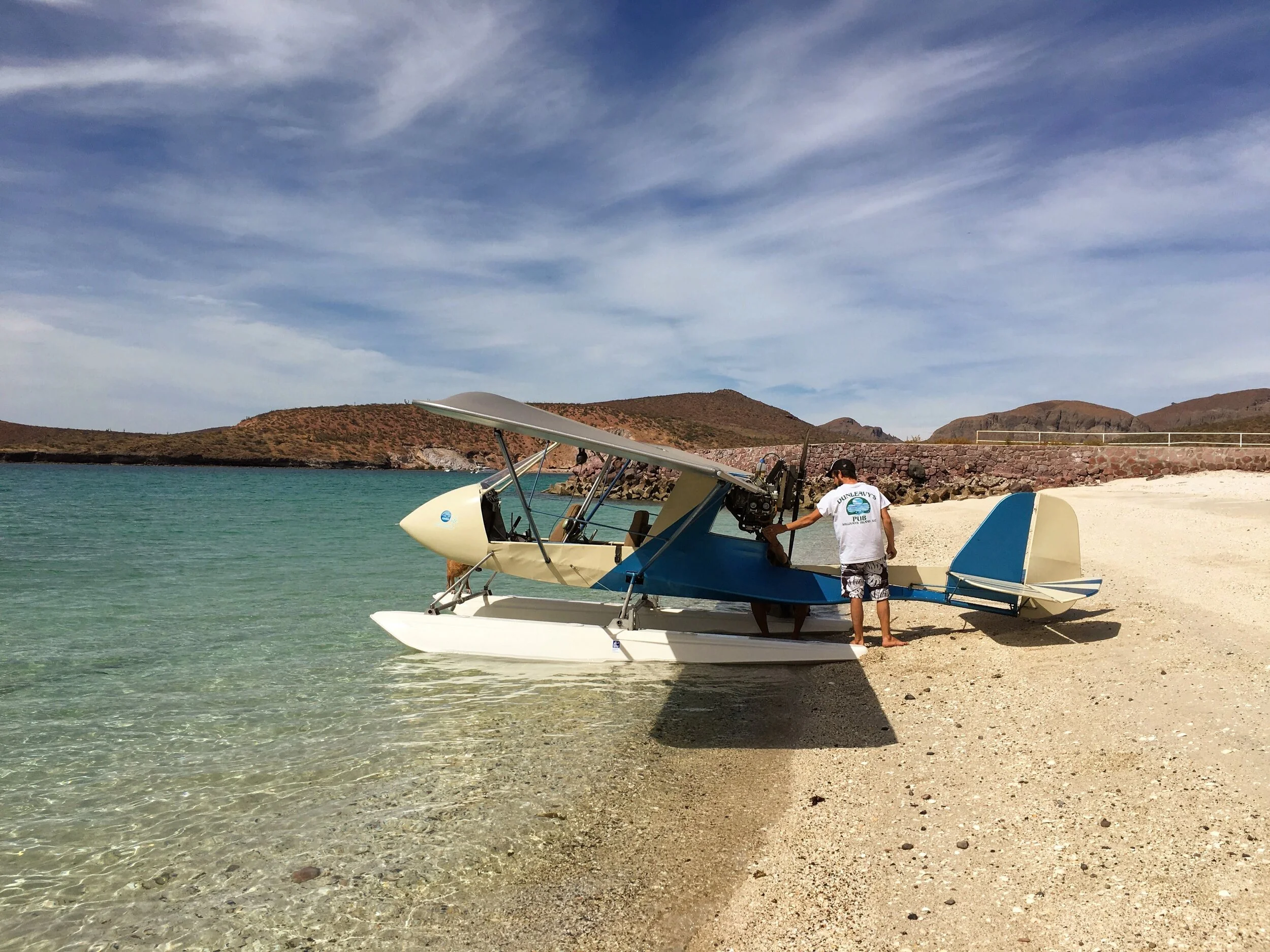Amidst the coronavirus shutdown, citizen scientists quarantining on their sailboats in Mexican waters continue to report their sea turtle sightings via Upwell’s Sea Turtle Spotter project. Their reports are astonishing! With tourism halted and only a few small-scale fishing pangas operating, Sea Turtle Spotters are observing sea turtles in bays and inlets where sightings are usually rare. Bays normally packed full of tourist boats racing in and out, ferrying snorkelers and divers from all over the world, are quiet and teeming with sea turtles.
Following on these reports, Upwell’s resident researcher in Mexico, Stephanie Rousso, arranged with a local pilot to take to the sky for a bird’s eye view of sea turtle distribution around the southern end of the Baja California Peninsula.
A few scattered sailboats anchored in Balandra Bay, which remains closed to public tourism.
As Captain Siddartha, the pilot and owner of "Ocean Life Aerial Conservation" fueled and prepared the two-seater seaplane, the weather changed from clear and calm to gusty, strong winds. This is a common occurrence in the southern Gulf of California, where the nutrient-rich waters of both the Gulf of California and the Pacific Ocean converge at the foot of the Baja Peninsula. Undeterred, Stephanie and Captain Siddartha decided to brave the bumpy conditions to find out what they could about sea turtle distribution from the air.
Captain Siddartha readies the seaplane for flight.
Captain Siddhartha and Stephanie’s original flight plan called for heading south over the Ensenada of La Paz, an inlet at the southern end of La Paz Bay (the largest bay in the Gulf of California), where citizen scientists had reported green turtles.
Citizen science reports indicate turtles are exploring new foraging areas absent splashing, noisy humans and free of whirling propellers. Researchers believe sea turtles are highly sensitive to vibrations and shadows. Although turtles can remain at depth for long periods of time to avoid unwanted interactions, they still need to surface for air and may risk boat strikes. Stephanie hypothesizes that turtles who normally seek refuge from boat traffic in the shallow waters around the mangroves are now exploring wider areas of La Paz Bay.
Unfortunately, high winds prevented Siddartha and Stephanie from exploring the southern portion of the bay, so they headed north toward the Espiritu Santo archipelago in search of turtles. Siddhartha maintained the plane’s course at distance from the islands in adherence to restrictions set by the Mexican Commission for Protected Natural Areas (CONANP) to protect species in the national park. The windy conditions created whitecaps on the ocean’s surface, making turtle spotting in the bays impossible. With a half tank of fuel left, they decided to change course again to fly over the middle of the La Paz Bay.
Here, they could distinctly see turtles in a calmer area studded with pockets of floating sargassum. This macroalgae (seaweed) is an important food source for sea turtles and provides refuge, especially at the hatchling stage. Sargassum also provides habitat for foraging juveniles and adults. The floating mats of marine algae attract myriad prey for sea turtles from pelagic red crabs (a favorite of loggerheads), jellyfish (favored by Pacific greens and leatherbacks), and other marine invertebrates (likely enjoyed by the omnivorous olive ridley).
The windy conditions continued to present challenges for photography, especially since Stephanie was strapped in with a waist seat belt in an open-air plane with no doors or side windows. She only had a split second to capture the turtles as they surfaced for air. When she had the opportunity to review the photos on her computer, she was in for a surprise. They clearly showed several male green sea turtles, a very rare sighting. Scientists can only identify a turtle as a male when they are fully reproductive adults, based on the elongated tail. (Evolution favored male turtles with longer tails to hold a more extensive reproductive organ to increase in-water mating success.)
A male green sea turtle visible, only briefly, from above.
This finding indicates that La Paz Bay may be more important for sea turtle conservation than originally thought. If male turtles are present and mating occurs in La Paz Bay, the area could merit further protections. Our partners at Grupo Tortuguero de las Californias (GTC), a non-profit in NW Mexico, have documented several adult females in the adjacent national park, but very few males. Current estimates of local green sea turtle populations are based on in-water monitoring at specific sites in the national park; little research has been conducted outside the park and in the bay. Stephanie could not adequately capture active mating in her aerial photographs; her flights to date have yielded only blurry photos of males circling a female. Still more curious to biologists, there is no documented nesting beach for green sea turtles in the entire Baja Peninsula, which contrasts with the dominant perspective that turtles mate in waters off nesting beaches. The nearest well-documented green turtle nesting beaches are in the state of Michoacan, almost 1500 kilometers from La Paz.
La Paz Bay is heavily fished for finfish and sharks that are consumed locally and nationally, as well as exported to the U.S. and Asia. Fisheries bycatch is the highest factor associated with sea turtle mortality in the region, with boat strikes and plastic pollution following close behind. Demand for "turtle-safe" seafood is growing, but increasing supply depends on dedicated efforts to build conservation capacity and relationships of trust with small-scale fishing cooperatives. To measure our progress toward bycatch reduction, we need to establish a baseline and monitor turtle populations. Upwell is contributing to these efforts by conducting flyover monitoring of key marine habitats, documenting strandings related to at-sea threats (e.g., dead turtles washed ashore after being caught in fishing nets), and directly engaging with fishing cooperatives trained by GTC to collect vital data on bycatch. All of these activities are central to Upwell's mission of protecting sea turtles at sea.




